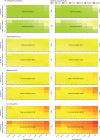Estimating excess 1-year mortality associated with the COVID-19 pandemic according to underlying conditions and age: a population-based cohort study
- PMID: 32405103
- PMCID: PMC7217641
- DOI: 10.1016/S0140-6736(20)30854-0
Estimating excess 1-year mortality associated with the COVID-19 pandemic according to underlying conditions and age: a population-based cohort study
Abstract
Background: The medical, societal, and economic impact of the coronavirus disease 2019 (COVID-19) pandemic has unknown effects on overall population mortality. Previous models of population mortality are based on death over days among infected people, nearly all of whom thus far have underlying conditions. Models have not incorporated information on high-risk conditions or their longer-term baseline (pre-COVID-19) mortality. We estimated the excess number of deaths over 1 year under different COVID-19 incidence scenarios based on varying levels of transmission suppression and differing mortality impacts based on different relative risks for the disease.
Methods: In this population-based cohort study, we used linked primary and secondary care electronic health records from England (Health Data Research UK-CALIBER). We report prevalence of underlying conditions defined by Public Health England guidelines (from March 16, 2020) in individuals aged 30 years or older registered with a practice between 1997 and 2017, using validated, openly available phenotypes for each condition. We estimated 1-year mortality in each condition, developing simple models (and a tool for calculation) of excess COVID-19-related deaths, assuming relative impact (as relative risks [RRs]) of the COVID-19 pandemic (compared with background mortality) of 1·5, 2·0, and 3·0 at differing infection rate scenarios, including full suppression (0·001%), partial suppression (1%), mitigation (10%), and do nothing (80%). We also developed an online, public, prototype risk calculator for excess death estimation.
Findings: We included 3 862 012 individuals (1 957 935 [50·7%] women and 1 904 077 [49·3%] men). We estimated that more than 20% of the study population are in the high-risk category, of whom 13·7% were older than 70 years and 6·3% were aged 70 years or younger with at least one underlying condition. 1-year mortality in the high-risk population was estimated to be 4·46% (95% CI 4·41-4·51). Age and underlying conditions combined to influence background risk, varying markedly across conditions. In a full suppression scenario in the UK population, we estimated that there would be two excess deaths (vs baseline deaths) with an RR of 1·5, four with an RR of 2·0, and seven with an RR of 3·0. In a mitigation scenario, we estimated 18 374 excess deaths with an RR of 1·5, 36 749 with an RR of 2·0, and 73 498 with an RR of 3·0. In a do nothing scenario, we estimated 146 996 excess deaths with an RR of 1·5, 293 991 with an RR of 2·0, and 587 982 with an RR of 3·0.
Interpretation: We provide policy makers, researchers, and the public a simple model and an online tool for understanding excess mortality over 1 year from the COVID-19 pandemic, based on age, sex, and underlying condition-specific estimates. These results signal the need for sustained stringent suppression measures as well as sustained efforts to target those at highest risk because of underlying conditions with a range of preventive interventions. Countries should assess the overall (direct and indirect) effects of the pandemic on excess mortality.
Funding: National Institute for Health Research University College London Hospitals Biomedical Research Centre, Health Data Research UK.
Copyright © 2020 The Author(s). Published by Elsevier Ltd. This is an Open Access article under the CC BY-NC-ND 4.0 license. Published by Elsevier Ltd.. All rights reserved.
Figures





Comment in
-
Models for mortality require tailoring in the context of the COVID-19 pandemic.Lancet. 2020 Sep 26;396(10255):883. doi: 10.1016/S0140-6736(20)31967-X. Lancet. 2020. PMID: 32979971 Free PMC article. No abstract available.
References
-
- Spiegelhalter D. How much ‘normal’ risk does Covid represent? Medium. March 21, 2020. https://medium.com/wintoncentre/how-much-normal-risk-does-covid-represen...
-
- Ferguson NM, Laydon D, Nedjati-Gilani G. Imperial College; London: March 16, 2020. Impact of non-pharmaceutical interventions (NPIs) to reduce COVID-19 mortality and healthcare demand.https://www.imperial.ac.uk/media/imperial-college/medicine/sph/ide/gida-... - PMC - PubMed
-
- WHO . World Health Organization; Geneva: Feb 16–24, 2020. Report of the WHO-China joint mission on coronavirus disease 2019 (COVID-19)https://www.who.int/docs/default-source/coronaviruse/who-china-joint-mis...
-
- WHO Emergency Committee . World Health Organization; Geneva: Jan 30, 2020. Statement on the second meeting of the International Health Regulations (2005) Emergency Committee regarding the outbreak of novel coronavirus (2019-nCoV)https://www.who.int/news-room/detail/30-01-2020-statement-on-the-second-...
Publication types
MeSH terms
Grants and funding
LinkOut - more resources
Full Text Sources
Medical

